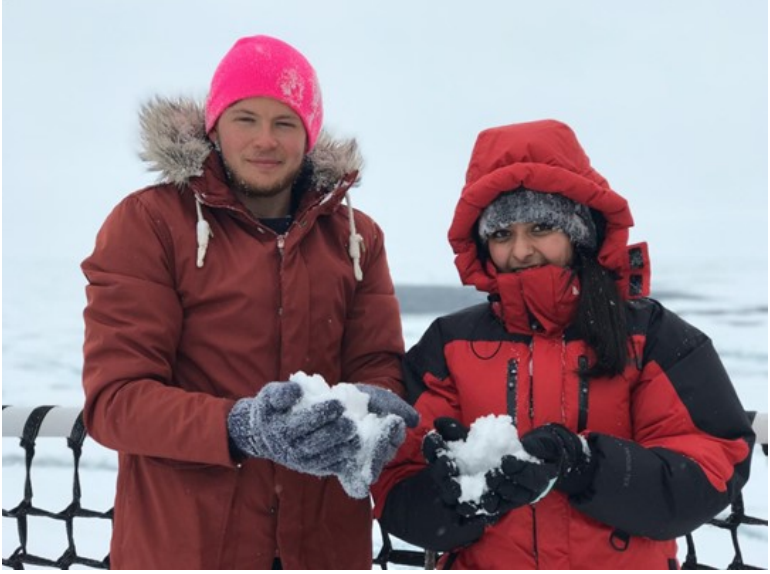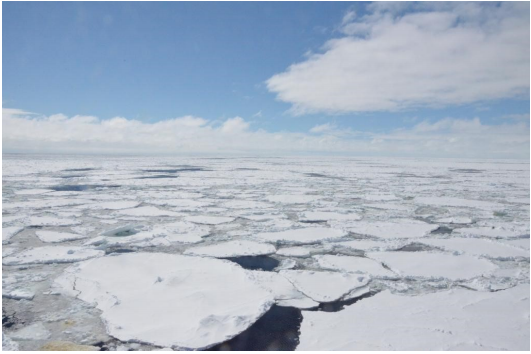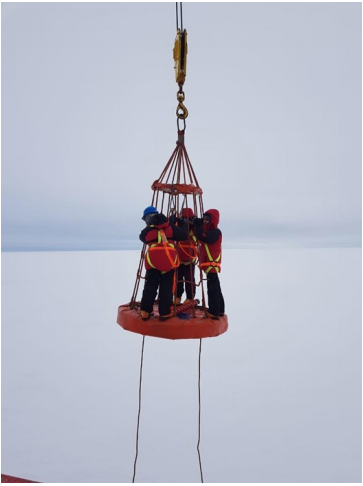Journeys of SCALE (Southern oCean seAsonaL Experiment)


UCT oceanography students Sejal Pramlall (right) and Riesna Audh (left) extracting an ice core.
An MSc and Honours student from the Department of Oceanography share their experiences of going on the Southern oCean seasonal Experiment research expedition:
Sejal Pramlall:
My first step on the Antarctic sea ice felt like landing on the moon. The four-person basket acted as the slow rocket that hoisted me from the comfort of the SA Agulhas II, and into the world of the Antarctic sea ice. I stepped onto the ice, and noticed an immense silence; the only sound being the crunch of the snow under the weight of my oversized pumpkin boots. The warm polar attire bore close resemblance to a space suit, both limiting mobility but nevertheless being highly necessary. The seemingly limitless expanse of the ice attested to the fact that I had now entered an environment that was untouched and uninhabited by man. Other human life is thousands of kilometers away, with the nearest life forms being wild and pristine. I took a breath; the air was crisp and clean. In that instant, I was cognisant of the fact that my past aspirations as an oceanographer were materializing at that very moment. My journey of the SCALE Spring Cruise 2019 had finally begun.
I was recruited to the SCALE research expedition as a member of the Sea Ice team, which is made up of a combination of UCT oceanographers and engineers under supervision of A/Prof Marcello Vichi and Prof Sebastian Skatulla. Our goal was to perform ice-coring operations, and to collect snow and water samples from the various Marginal Ice Zone (MIZ) stations. Each station began with the implementation of thorough safety procedures to ensure the ice could bear the weight of the team. The collection of samples was conducted efficiently and in accordance with sound scientific procedures. We treated each station as an opportunity to improve, surpassing the previous days achievements at each chance we had to get onto the ice. When not on the ice, I would be in the bridge conducting ice observations, which consisted of a thorough observation of sea ice conditions every 10 minutes, rolling over every 24 hours. This provided valuable information, which could be incorporated into the validation of satellite data. These in situ observations are a fundamental contribution to sea ice information.
Not only did I accumulate invaluable skills in the realm of sea ice data collection, but I was also exposed to numerous scientific fields during my voyage. I was fortunate enough to witness the tagging of two Ross seals, which is an exceptionally rare sighting. Down in the environmental hanger where the UCT biogeochemists dwelled, the CTD’s (Conductivity, Temperature Depth) and Bongo nets were deployed. The CTD uncovered data from the various ocean depths, which are used to discern the different water masses that make up our inhomogeneous ocean, along with the inherent chemical and biological signals within them. Through the microscope the contents of the Bongo nets were revealed – colourful krill and alien-like critters were the catch of the day, proving that an area that appeared barren to the untrained human eye was bursting with life and productivity.
SCALE has proven to be the umbrella under which numerous disciplines can thrive, as shown by the extensive cooperation between research fields. Witnessing the different teams work together with the common goal of furthering our understanding of the Southern Ocean was truly inspiring. The success of the SCALE cruise confirms my belief that a multidisciplinary approach is the key to progress. This is how all science should be approached, by exuding benevolent support and inclusivity for researchers from various backgrounds. I am grateful to have been involved in such an expedition, where I was part of a team that became family, I’ve learnt lessons that could only be taught by experience, and made memories that will last a lifetime. This experience reminds me of an African proverb I have heard that goes: ‘If you want to go fast, go alone; if you want to go far, go together.’

Oceanography honours students, Wayne de Jager (left) and Sejal Pramlall (right) enjoying the Antarctic snow during their first SCALE expedition
Jonathan Rogerson: The real SCALE cruise experience
Nervous glances and suppressed exhilaration stirred as 92 unlikely musicians took to their places on the odd stage that was the SA Agulhas II. Without a dress rehearsal, the curtains lifted in early October and we began our voyage down to the Antarctic. Inherently, an Antarctic vessel is no place for an orchestra, yet it was the perfect platform for what would be a rousing performance.

The field of pancakes (Taken by Felix Paul)
The iambic pentameter of the expedition was the science itself, to which the musicians were well versed in their pieces. The allure of the ice was multi-faceted for all as it held information relevant to the pressing and turbulent times of the 21st century as well as being an alien-like landscape that presented a virgin experience of adventure. Following in the wake of Shackelton and the Endurance as well as the undertakings of Scott and Amendson, the ice-covered wasteland beckoned its dangerous presence with strong storms and towering waves that left most of us pale and off-key. Like an impatient audience, the scraping and grouching of ice against the hull of the ship made for an unpleasant and constant murmur during our recital. As the musicians played their various pieces, the loud percussion of the ice-coring melded with the soft and careful work of the biogeochemical teams. All the while, the ebbing vocal choirs of quiet observers and raucous crew created the symphony that was the scientific act of the expedition.
As intermission was called, the weary musicians retired away from the labs and computer screens to indulge their tired brains with frivolous activities. For some, the warm and quiet embrace of a soft bed was sufficient; while for others, the playful and mindless banter with fellow performers acted as a welcome distraction from the stress. Inevitably, a few maverick individuals sought solace in the confines of the sauna. A harsh juxtaposition to the surrounding environment, where heat and humidity alleviated the aches and pains of performing with cool bodily sweat that dripped like a facet on the back of one’s neck which sent a slight pleasurable tingling through the spine. However, all the musicians enjoyed a stiff drink at the end of a long day which sometimes lead to humorous scenes of gallivanting, slight inebriation and communal drunkard chorus to familiar and homely tunes. Like a stalker, the activities and traditions of land were able to eke their way onto the ship when the victory of the Springboks punctuated the lethargic ship-time with orgasmic explosions of pride and patriotism. Similarly, the celebration of Halloween with intricate and obscure costumes left a sense a homeward yearning.

The ice team in transit, via the man basket
As the performance came to an end and the curtains closed, one was left elated with the realisation of shared accomplishment. No longer just fellow musicians, it was difficult to look from one face to another and not see a friend; united together in the love of science and knowledge. In the end, a cacophony of major and minor experiences was able to chaotically amalgamate together to create a seamless masterpiece of an adventure.

The ice team analyzing a recently extracted ice core, with the SA Agulhas II in the background.
Story: Science Faculty Newsletter - November 2019 Photos: Provided
